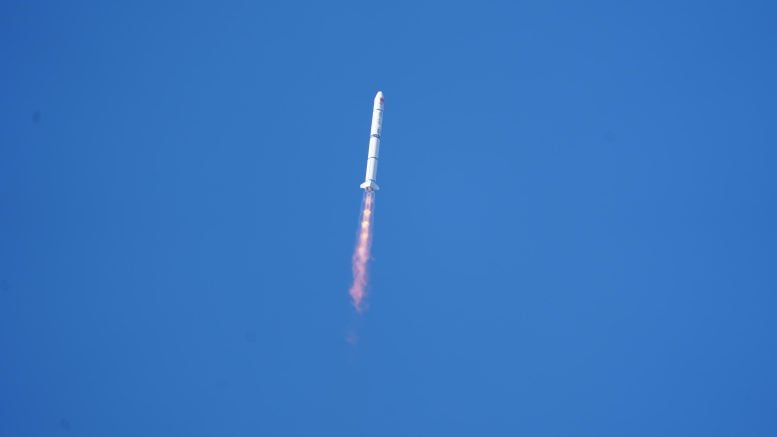By
The Einstein Probe, China’s new satellite equipped with advanced X-ray telescopes, is set to explore mysterious and violent cosmic events. The mission aims to enhance our understanding of the universe, focusing on transient phenomena like supernovas and black holes. Credit: Chinese Academy of Sciences
China’s Einstein Probe satellite launches to study the universe’s violent phenomena, aiming to uncover cosmic mysteries with cutting-edge X-ray technology.
China on Tuesday sent a new astronomical satellite into space to observe mysterious transient phenomena in the universe which flicker like fireworks, trying to reveal more about this violent and little-known side of the cosmos.
The satellite named Einstein Probe (EP), which uses new X-ray detection technology inspired by the functioning of a lobster eye, was launched by a Long March-2C carrier rocket at 3:03 p.m. (Beijing Time) from the Xichang Satellite Launch Center in southwest China’s Sichuan Province.
Weighing about 1.45 tonnes and as large as a full-size SUV, the satellite is shaped like a lotus in full bloom and features 12 petals and two stamens.
“This is the most beautiful satellite I’ve ever seen,” said Yuan Weimin, principal investigator of the EP mission and a researcher at the National Astronomical Observatories of the Chinese Academy of Sciences (CAS).

The Einstein Probe lifted off on a Chang Zheng (Long March) 2C rocket from the Xichang Satellite Launch Center in China at 15:03 CST / 07:03 GMT / 08:03 CET on January 9, 2024. Credit: Chinese Academy of Sciences
The 12 “petals” are actually 12 modules consisting of wide-field X-ray telescopes (WXT), while the two “stamens” consist of two modules of follow-up X-ray telescopes (FXT).
These telescopes form a space observatory that is aimed at helping scientists capture the first light stemming from supernova explosions, search for and pinpoint X-ray signals accompanying gravitational wave events, and discover dormant black holes and other faint transient and variable celestial objects at the far reaches of the universe.
“Since black holes and gravitational waves are predictions made by Einstein’s theory of general relativity, the satellite is named after the great scientist,” Yuan said.
Violent Universe
The starry sky visible to human eyes is quiet and peaceful, but in reality, there are many fierce celestial activities in the universe, such as explosions triggered by the death of supermassive stars, black holes tearing apart and devouring stars, and collisions between bizarre neutron stars and black holes, Yuan said.
Ancient Chinese astronomers recorded a bright supernova explosion in 1054 A.D., and the remnants of this event, the Crab Nebula and a neutron star, were found nearly 1,000 years later by modern astronomers.
“These explosive celestial bodies are also part of our universe, and usually at the critical stage of celestial evolution. We are still unclear about many of their physical properties and processes. Studying them can help us better answer the most fundamental scientific questions, such as what the universe is made up of, what physical laws govern the extreme universe, and how stars evolve and die,” Yuan said.
These extraordinary explosions often emit X-rays, which cannot penetrate the Earth’s atmosphere. It wasn’t until humans had the ability to send probes into space that the hot and energetic side of the universe was unveiled in the X-ray band.
Lobster Eyes in Space
Only a limited number of such sudden and unpredictable explosive celestial bodies and events, so-called transient sources, have been found in the deep universe beyond our own galaxy. “It’s like fishing in a river. We need a very large net, since we don’t know where the fish will come from,” said Ling Zhixing, a WXT instrument scientist.
WXT on the satellite are the “large nets” used by scientists to capture their “prey” in the universe. The 12 modules can keep an eye on one-twelfth of the entire sky at one glance, according to Ling.
Scientists mimicked the special structure of the lobster eye in developing WXT, which can simultaneously achieve wide-field observation and X-ray focused imaging.
FXT, developed by an international team led by Chinese scientists, feature high sensitivity and are not only suitable for rapid follow-up observation, but also able to independently discover explosive and transient sources, said Chen Yong, a researcher at the Institute of High Energy Physics of the CAS, who is responsible for the development of FXT.
When lobster-eye telescopes receive X-ray signals from a transient source, the onboard computer will process the data in real-time and pivot the spacecraft to target the celestial body with FXT. FXT will then conduct high-precision follow-up observation. The two telescopes will complement and cooperate with each other, said Zhang Chen, assistant to the EP mission’s principal investigator.
The team also developed CMOS sensors for X-ray observation in space, which is an innovative X-ray astronomical detector, Zhang said.
The mission aims to conduct a high-cadence survey and monitoring of high-energy transient sources, search for cloaked black holes and study their formation and evolution. The probe will also be used to search for X-ray signals accompanying gravitational wave events and to pinpoint them. Neutron stars, white dwarfs, supernovae and gamma-ray bursts are also observation targets of this mission.
“I’m looking forward to discovering new phenomena and celestial bodies that have never been seen before,” Yuan said.
The European Space Agency and the Max Planck Institute for Extraterrestrial Physics in Germany are also participating in this mission.





